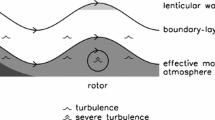Summary
The development of a convective boundary layer over the Antarctic Plateau is documented by a Doppler minisodar data-set recorded during a 10 day campaign in January 1997. The vertical velocities associated with thermals do not exceed 1 m/s, while the depth of the convective layer, usually less than 200 m, never surpasses 300 m. Measurements of momentum flux, sensible heat flux, wind speed and radiation budget show characteristics that are typical of a convective boundary layer evolution. The diurnal behaviour of absolute humidity, however, exhibits features that are not expected, e.g. anticorrelation with incoming net radiation and air temperature.
Similar content being viewed by others
Author information
Authors and Affiliations
Additional information
Received October 30, 1998 Revised May 26, 1999
Rights and permissions
About this article
Cite this article
Mastrantonio, G., Malvestuto, V., Argentini, S. et al. Evidence of a Convective Boundary Layer Developingon the Antarctic Plateau during the Summer. Meteorol Atmos Phys 71, 127–132 (1999). https://doi.org/10.1007/s007030050050
Issue Date:
DOI: https://doi.org/10.1007/s007030050050




